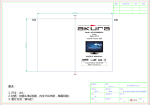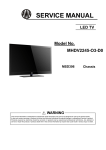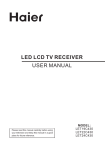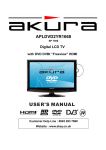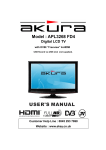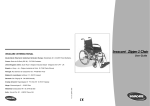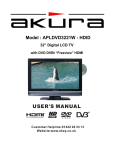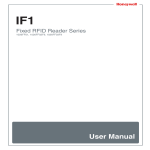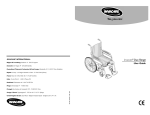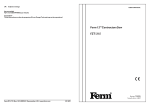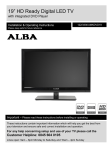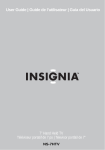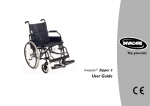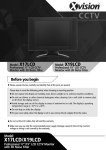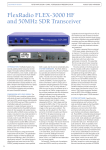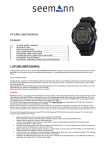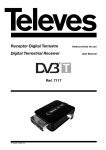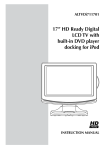Download APLDVD1968UCR
Transcript
APLDVD1968UCR MSD306 Digital LCD TV With DVD,DVBt “Freeview”, HDMI & PVR Record via USB Memory stick or Hard drive (not supplied). Customer Help Line : 0845 293 7698 Website : www.ekey.co.uk Contents 1. Safety Information 2 2. Safety Instructions 2 3. Digital Switch over 3 4. Accessories 4 5. User Controls 5 6. Remote Control 6 7. Connections 8 8. Menu Operation 10 First Time Installation 11 Tuning 12 Firmware upgrade. 13 Cam Module 14 Recording 15 Picture menu 16 Sound Menu 17 Time Menu 17 Option Menu 18 Lock Menu 18 9. EPG (Electronic Programme Guide ). 19 10. Digital Radio 19 11. Teletext (Analog) 20 12. Teletext (Digital) 20 13. Media 21 PVR Record 21 PVR Playback 23 14. DVD and SD Card 25 15. DVD Setup 26 16. Disc care 27 17. Trouble Shooting Guide 28 18. Wall Mounting 29 19. Specifications 30 Rovi Statement 30 Contact details 30 1. Safety Information The lightning flash with arrowhead symbol, within an equilateral triangle, is intended to alert the user to the presence of un-insulated “dangerous voltage” within the products enclosure that may be of sufficient magnitude to constitute a risk of electric shock to the persons. The exclamation point within an equilateral triangle is intend to alert the user to the presence of important operating and maintenance (servicing) instructions in the literature accompanying the appliance. Correct disposal of this Product (Waste Electrical & Electronic Equipment (WEEE) The crossed out “Wheelie bin” is intended to show that this appliance must not be placed with ordinary household waste at the end of its useful life. To prevent possible harm to the environment or human health from uncontrolled waste disposal, please keep separate from other household waste and recycle it responsibly to promote the sustainable reuse of material resources. Household users should contact either the retailer where you purchased the product, or their local government office for details of where and how you can take this item for environmentally safe re-cycling. Business users should contact their supplier and check the terms and conditions of the purchase contract. This product must not be mixed with other commercial wastes for disposal This unit has a “CLASS 1” laser assembly. It produces a visible laser beam which could cause hazardous radiation exposure. Ensure the product is operated as instructed. Do not remove any covers or look into the DVD drawer opening whilst power is applied. Do NOT modify or adjust any controls that may affect laser emissions. Should the product become faulty consult a qualified technician. This appliance complies with European Safety and Electrical directives 2. Safety Instructions CAUTION. PLEASE READ AND OBSERVE ALL WARNINGS AND INSTRUCTIONS GIVEN IN THIS USER MANUAL AND MARKED ON THE APPLIANCE. RETAIN THIS BOOKLET FOR FUTURE USE. This set has been designed and manufactured to assure your personal safety. Improper use can result in Electric shock or Fire hazard. The safeguards in this appliance will protect you if you observe the correct procedures for installation, servicing and operation. There are NO user parts inside. DO NOT REMOVE THE CASE OR OTHER COVERS OR YOU MAY BE EXPOSED TO DANGEROUS VOLTAGES OR LASER RADIATION AND WILL INVALIDATE YOUR WARRANTY. REFER ALL SERVICING TO QUALIFIED SERVICE PERSONNEL. 2 2 2 2. Safety Instructions Unpacking and Handling. Open the carton carefully and remove the polyfoam packing. Carefully lift the TV and place onto a firm stable surface. Lift off the Poly bag and retain all packaging for future use. Keep all packaging away from small children and animals. Placing TV. The TV should be placed on a firm table or shelf. If placing in a cabinet ensure there is sufficient spacing for air flow. Also allow sufficient space for DVD discs to be placed into and removed from the DVD slot For wall mounting please see page 29. Ventilation and Heat Sources. Do not place material over the ventilation slots, this will cause the TV to overheat and fail. Do not place the TV in direct sunlight or near heat sources such as radiators or fires. Ventilation slots. Do not allow objects to be dropped inside the ventilation slot, this could cause a short circuit and a possible fire. Do not allow chains to be dangled into the TV. A serious electrical shock my occur. Candles and Open flames. Do not place lighted candles (“T” Lights) on the top or at the sides of the TV, or any other naked flame near the TV cabinet. Connections. When connecting the TV to external sources and the mains supply, do not place wires that can be tripped over. Do not trap or place heavy objects on the mains lead or adaptor. Class One. This apparatus is a “Class One” device and must only be connected to a mains supply with a protecting EARTH connection. Dis-connection Device. Where the MAINS plug or appliance connector is used as the Disconnection device, the disconnect device shall remain operable and MUST be accessible at all times. Moisture. Do not place the TV in wet or damp conditions, such as steamy kitchens, basements or other damp places. Do not allow water or other fluids to enter the TV. Do not touch the Mains plug or adaptor with wet hands. Should moisture enter the TV, disconnect from the supply and call the customer help line. Cleaning. Disconnect the TV from the mains supply. Use a soft dry cloth, for stubborn stains use a soft moist cloth with a dilute mild detergent.. Do NOT use petrol based fluids or abrasive materials. LCD Screen. Do not hit or cause impact to the LCD screen. The screen consists of many individual pixels and is easily damaged. Bright or dark dots may occur and are not covered by warranty. Lightning. During a thunderstorm or when leaving the appliance for long periods such as holidays, disconnect the aerial input (if external aerial) and remove the mains plug, This is to prevent power surges damaging the apparatus Headphone Use. When using headphones do not use for long periods. Loud music can permanently damage your hearing. 3. Digital Switchover DIGITAL SWITCH OVER AND YOUR TV. WHAT YOU NEED TO DO TO ENJOY WATCHING TV DURING AND FOLLOWING DIGITAL SWITCH OVER. Starting in 2008 and ending in 2012, television services will go completely digital, TV region by TV region. To continue using this digital TV during and following the digital switchover, you will need to “reset” your digital TV channels. Users of this digital TV must reset on at least 2 different occasions, normally 1 month apart when your switchover happens. Digital UK, the body leading the digital switchover, and broadcasters, will advise you when to reset your digital channels on each occasion. If you do not reset your digital channels, you risk loosing some or all of your TV services during and following switchover. Please refer to this instruction manual to retune the Digital TV services. Do NOT use “ADD” channels, you MUST “AUTO TUNE” and allow a complete retune. (See page12) For more information please contact the “Customer Help Line” (Page 29 or visit www.digitaluk.co.uk 3 4. Accessories Please check the contents of the box before you continue. If any item is missing please contact your point of purchase. Remote Control User Manual Mains lead 4 x M4 x15mm wall mounting spacers Base stand and 4 x M4 x10mm mounting screws 4 4 4 5. User Controls. Top view POWER INPUT 1. Power. : Turns TV On from standby. Also returns TV to standby. 2. Vol – : Reduces Volume level. 3. Vol + : Increases Volume level. 4. CH : Reduces channel selection by 1 with each press. 5. CH + : Increases channel selection by 1 with each press. 6. Menu. : Selects the MENU function. If in a sub menu, will revert to previous level of menu. 7. Input. : Selects the different input sources. 8. POWER INPUT.: Mains supply input 100 – 240V AC 50/60 Hz 9. LED. : Displays TV status. In standby illuminates Red, when in use illuminates Green. 10. I R Lens. : Remote control receiver lens. Do not obstruct or cover. DVD Controls Side view 1. Press to insert or eject disc from player. 2. Press to play and pause disc. If paused press again to restart playing. 3. Press to Stop disc playing. *For all other functions use the Remote Control*. 5 5 6. Remote Control. 1. POWER. Switches TV to Standby and Operation. 3. P MODE. Selects picture modes. 5. S MODE. Selects sound modes. 7. 0-9. Numeric buttons for direct channel selection or track/chapter numbers. 9. EPG. Selects Electronic Programme Guide.. 11. UP. Navigation button 13. LEFT. Navigation button. 15. DOWN. Navigation button. 17. VOL -. Volume down button 19. VOL +. Volume up button 21. TXT/REPEAT. Selects Teletext. Repeat, sets Repeat points. 23. HOLD/A-B.Hold freezes text pages A-B selects the points of repeat in DVD mode. 25. INDEX/SETUP Index Selects Text index. Setup Sets parameters of DVD settings. 27. SIZE/DVD MENU. Size changes Text size in Analog text mode. DVD Menu Selects DVD disc contents menu. In SVCD mode selects PBC On/Off. 29. RED/PROGRAM. Fast text mode button. Select button in PVR mode. Program. Allows you to select different points of a CD or MP3 disc to play. 31. GREEN/GOTO. Fast text mode. Select button in PVR mode. Goto Allows you to set the GOTO position on DVD discs. 2. INFO. Displays TV settings and channel being viewed. 4. MUTE. Press to mute sound, press again to restore sound. 6. ASPECT. Selects different picture size modes 8. NICAM. In Analog TV mode switches between Mono and Nicam. In Freeview mode selects different soundtracks if transmitted. 10. FREEZE. Freezes picture. Press again to restore normal viewing. 12. SLEEP. Sets sleep timer, sets from 10 minutes to 4 hrs 14. MENU. Enters Setup menus.. 16. SOURCE. Selects various input modes. 18. RECALL. Recalls previous channel viewed. 20. OK. Confirmation button. 22. RIGHT. Navigation button. 24. CH+. Channel UP select. 26. CH-. Channel DOWN select. 28. SUBPAGE/SUBTITLE. Subpage selects subpages in Text mode. Subtitle displays subtitles in Analog, and Freeview modes 30.MIX/LANGUAGE. Mix displays mixed text and picture. Language selects languages in DVD mode 32. EXIT/CANCEL/ZOOM. Exits setup menus. Zoom, Selects picture size in DVD mode. 33. PLAY/PAUSE. Plays and Pauses DVD and PVR modes 35. LIST/STOP. List. Displays list of recorded material in PVR mode.Stops playback in DVD and PVR modes. 37. RECORD/EJECT. Press to record DTV Programmes. Eject. Ejects DVD discs 39. T-SHIFT/CARD/DISC. T Shift Starts time shifting in Freeview operation. Card/Disc selects DVD or SD Card mode. 41. DTV/Radio/FAST REWIND. DTV/Radio selects Radio or TV in Freeview mode. Fast rewind in DVD/PVR mode. 34. REVEAL/TITLE. Reveals hidden answers in Text quiz pages.Title displays DVD title information. 36. BLUE/D DIS. Fast text mode. Select button in PVR mode. D Dis, shows DVD disc information 38. YELLOW/ANGLE. Fast text mode. Angle . Selects viewing angle on DVD. Select button in PVR mode. 40. FAV/ FAST FORWARD. Fav displays Favourite program list. Fast Forward in DVD and PVR modes. 42. PAGEDOWN/NEXT. PageDown selects previous page in Text mode. Next Selects next track or file. 43. REWIND/PAGE UP. Rewinds playback in DVD/PVR mode. Page up. Selects next page in Text mode 6 6 5 5 6. Remote Control. Battery Fitting and Disposal 1. 2. 3. 4. Open the battery cover Fit two “AAA” batteries “not supplied”. Ensure the battery polarities are correct i.e + to + and – to -. Replace the battery cover To prevent injury, do NOT break open or throw exhausted batteries in a fire. Do not mix batteries, old and new, Carbon or Alkaline. Do not use re chargeable batteries. Remove batteries if not using the remote control for long periods to prevent leakage. If the batteries do leak, clean the compartment with soapy water and scrape any residue from the contacts. To NOT touch or ingest battery residue. Should you swallow chemicals leaked from a battery, please URGENTLY consult a medical adviser. In the event that the remote control does not function, please check that the + VE end of the battery terminals are in contact with the connection spring. Some batteries have a smaller + VE terminal and may not reach the spring. You can stretch the spring slightly to ensure connection Do Not place used batteries in domestic waste, consult your battery retailer or your local waste disposal company for advice.”. 6 7 7 7. Connections. IMPORTANT. When making connections ensure the TV is disconnected from the MAINS supply input, and that the appliance being connected is also disconnected from the mains supply. HEAD PHONES TUNER. USB. AUDIO L/R. CVBS. Y,Pb,Pr. CI SLOT. SCART 1. PC AUDIO. VGA. HDMI. SCART 2. : Stereo output to headphones only. : RF input from TV aerial or cable source.( 1 m/V @ 75 Ω) typical. : PVR interface. : Low level audio inputs used in conjunction with CVBS : Low quality video input (1vPP 75 Ω). : Interlace or Sequential Component Video Input, “typical use PS3 or X Box”. : Place a CAM (Conditional Access Module) into this point to allow a “Pay per View” card. : Audio /Video input and output. (General quality). : Stereo audio input from PC (Used in conjunction with VGA input). : PC input (RGB). : Input from HDMI source (High Definition). : Audio/Video input only. (General quality). Typical connections CVBS AV Input Headphones. Plug in headphones. Set volume level for comfortable listening. Note :- Do NOT use headphones at high volume levels for prolonged periods. HDMI Input Connect CVBS and Audio L/R (if required). Use SOURCE button to select AV Connect HDMI input. Use SOURCE button to select HDMI 8 8 7 7. Connections. PC connections. Connect VGA (15 pin) plug to TV and PC. Connect stereo audio lead. Use SOURCE button to select VGA. Antenna or cable SCART 1 or 2. Connect scart lead to TV and appliance. Use SOURCE/INPUT button to select SCART1 or 2. In some circumstances the TV will automatically select scart when the appliance is used. Y,Pb,Pr Connect Y,Pb,Pr leads and audio leads to TV and appliance. It is wise to use dedicated Y,Pb,Pr leads from your retailer. Use SOURCE/INPUT button to select Y,Pb,Pr. SD Memory Card. Located adjacent to the DVD disc slot. Place card into slot as shown. To select, Select DVD mode Hard Drive or Memory Stick. Switch TV to standby and and press T- Shift/ insert either the USB Hard Drive or USB memory stick. DVD/Card button on Use SOURCE/INPUT button to select “MEDIA” the remote control. 9 8 9 7. Connections. Source/ Input Menu. To access the Source menu, press the SOURCE button on the Remote Control or the INPUT button on the TV. Using the ▲/▼ buttons select the Source / Input required and press OK to select. 8. Menu Operation. Connect the TV to the Mains supply and suitable aerial. It is advisable not to connect other apparatus until you have established that the TV is working correctly. If using the TV for DVBt (Freeview) viewing the existing aerial may not be suitable. Indoor aerials (set top) may not be suitable for some of the received stations. If stations are missing, freeze or break up, it is certainly the aerial signal that is not sufficient. Turn on the power and a Red led will be displayed in the lower right corner. Press either the Power button on the remote control or the Power button on the TV. The led will now turn Green and the screen will light up after approx 5 seconds. At this stage no stations will be stored. 10 10 9 8. Menu Operation. First Time Installation The first time the TV is connected and turned on you will see Fig 1. Fig 1 Using the ▲/▼ buttons select OSD Language, this is defaulted to English. If you require a different language, use the ►/◄ buttons to select a language of your choice. COUNTRY. Defaulted to UK. If you are in a different country, select “COUNTRY” use the ►/◄ buttons to select your country of choice. TUNE TYPE. In the UK select ATV/DTV. If in an area that has fully converted to Digital TV select DTV. When the selections have been made press “OK” and Fig 2 will be displayed. The TV will now tune all the TV signal spectrum. As tuning progresses it will display the number of stations received in each mode. Fig 2 When tuning is completed, BBC1 (DTV) will be displayed. To see a list of the “Stations” received, press (LIST) on the R/C. Fig 3 will be displayed. Use the ▲/▼ buttons to see the complete listing. To select a station press OK It may occur that the Analog Stations are not in the correct order to change the order see page 13 11 11 Fig 3 8. Menu Operation. Menu. To enter the Menu functions press the “MENU” button on either the TV or the R/C. Fig 4 will be the first menu to be displayed. At the top of the Menu are a number of symbols, these symbols display the type of menu function, these are “in order” :- Tuning, Picture, Sound, Timer, Options and Lock. To select any of these functions use the ►/◄ buttons. To Enter the menu use the ▲/▼ buttons. Fig 4 Tuning. Autoscan. Should the TV need retuning due to, relocation or DTV upgrades, select AutoScan and press OK. Fig 5 will be displayed. Use the ▲/▼ buttons to select “Country” and the ►/◄ buttons to select. (UK is default). TuneType. In the UK select ATV/DTV. If in an area that has fully converted to Digital TV select DTV. DTV Manual Tuning. “Fig 6”. Occasionally Manual tuning may be required. Use the ►/◄ buttons change the Channel number. At the bottom of the menu, a Signal Quality/Strength bar is shown, any signal below normal will probably display a “Freezing or Pixilated” picture. Press “OK” to start the Manual Tuning. The OSD will then show the number of stations received on that channel. Note :- In certain areas where two Digital TV areas overlap, e g Wales, the stronger signal may take “priority”. In this case Manual Tuning is essential. ATV Manual Tuning. “Fig 7”. Occasionally Manual tuning may be required. Storage to. This is the “Memory location” and can be changed with the ►/◄ buttons. System. This is the “Sound setting”. In the UK this is “I”. In Western Europe it is “B/G”, in Eastern Europe it is “D/K”. France is “L” or “LL”. “Default is “I”. Select using the ►/◄ buttons. Current CH. This is the actual channel location the TV is receiving. If adding a TV game or other device with a TV signal output, set this to a channel with no signal. Select using the ►/◄ buttons. Search. Use the ► button to increase the frequency. Use the ◄ button to decrease the frequency. To stop searching press “Exit”. If a signal is found, check that it is the one required. Use the ▲/▼ buttons to select “Storage to”, change the number using the ►/◄ buttons and press the RED button to save all the settings. Fine Tune. In some unusual circumstances the Sound or Picture may need “Fine Tuning”. Use the ►/◄ buttons. To increase or decrease the frequency. Each press of the button changes the frequency by 5 Khz. Press the RED button to save all the settings. 12 12 Fig 5 Fig 6 Fig 7 8. Menu Operation. Program Edit. DTV. Fig 8 In this menu you may perform four functions. Skip, Lock, Favourite and Delete. Skip. Use the ▲/▼ buttons to select which stations you wish to skip. Press the “Blue” button. An indicator will be placed in the Skip column. To remove, select again and press the Blue button. The Skip function only stops selection of the selected station when using the CH+/CHbuttons. Direct number entry works normally. Lock. Displays which stations have been locked. To change status you must see page 17. FAV. To add stations to a “Favourite” list, use the ▲/▼ buttons to select which stations you wish to add. Press the “FAV” button on the R/C. To un select press the FAV button again. Delete. To remove any station from the listing, use the ▲/▼ buttons to select which stations you wish to delete and press the RED button. If a mistake has been made, you must select AutoScan to re install all the stations. Program Edit. ATV. Fig 9 In this menu you may perform six functions. Skip, Lock, Favourite, Delete, Move and Rename Skip. See above. Lock. Displays which stations have been locked. To change status you must see page 17. FAV. See above. Delete. See above. Move. When “Auto Tuning” in Analog mode, it is possible that the stations may not be in the correct order. To move any stations, use the ▲/▼ buttons to select the station. Press the YELLOW button. The line will “widen” to show it has been selected. Use the ▲/▼ buttons to select the new location and press “OK”. The station will now be in the new location. Rename. It is possible to rename any station in Analog mode. Use the ▲/▼ buttons to select the station. Press the GREEN button. The Station name text will be highlighted. Use the ▲/▼ buttons to change the letter highlighted, a full letter/numeric alphabet is available. To select the next letter or digit use the ►/◄ buttons. To confirm the change press “OK” Fig 8 Fig 9 Fig 10 Signal Information. Select using the ▲/▼ buttons. A typical display is seen opposite “Fig 10”. This is for information only and cannot be changed. Firmware Upgrade OAD. This is set to “ON” as default. If an upgrade signal is received, you will see a message as in Fig 10A. Select Yes to upgrade and No to decline the upgrade. If Yes is selected the TV will automatically upgrade the firmware. 13 13 Fig 10a 8. Menu Operation. CI Information (DTV). Fig 11 Using a CAM (Conditional Access Module) (CI Slot). This feature allows the user to access digital terrestrial “pay per view” channels. To use this facility a conditional access module (CAM) and viewing card need to be obtained by subscribing to a pay channel company. To insert the module. Ensure the TV is fully disconnected from the power source. Insert the CAM into the CI slot with the label facing the front of the TV (Fig 11). A positive stop should be felt if correctly fitted. DO NOT force the module. To release the CAM push the button adjacent to the card and slide the module away from the TV. Fig 12 Reconnect the TV and switch on. Select DTV. Insert your “Pay per view” card. “Do NOT touch the gold contacts” Press the LCD Menu button and select DTV Setting menu. Select CI Information and press ►. To check the module is working use the ▲/▼ buttons to select Module Information and press OK, you should now see the information as in Fig 33 To check the card is working Ok select CI Information and press OK. If everything is ok you will see a list as Fig 12. If the information is not present, remove the card reverse and reinsert. This information should now be seen. Fig 13 Exit the menu’s by pressing OK or Exit and you are ready to view “Pay per view” channels. Figs 13 and 14 show the module and card information. To obtain the CAM and pay per view card, these may be purchased from good high street stores. Fig 14 14 14 8. Menu Operation. Record Start (DTV). Fig 15. PVR recording may be started from this menu. Select using the ▲/▼ buttons and press “OK”. Fig 15 Recorded List (DTV). Select this to see the list of programmes already stored on your memory system. Recorder Mode (DTV). You may set a “Timer Recording” using the menu in Fig 16. Use the ▲/▼ buttons to select each function. Use the ►/◄ buttons to select the changes required. You may set more than one “Timer Recording”, however you must ensure the times do NOT overlap. Schedule List (Fig 17). Shown below is the Timer Schedule List. This displays the status of set timer recordings. You may delete any setting or previous successful recordings. Select by using the ▲/▼ buttons, and Delete using the RED button. Fig 17 PVR File system. This is described on page 21 15 15 Fig 16 8. Menu Operation. Fig 18 Picture Menu. (Fig 18). Picture Mode. There are four settings. Standard, Mild, User and Dynamic. “Standard is set as default” Standard. Select for viewing in normal room lighting. Mild. Select when viewing in subdued room lighting, this will help prevent eye strain. User. This allows you to set your own levels of Brightness, Contrast and Colour. Dynamic. Select when using in bright room lighting conditions. These selections may also be selected using the “P MODE” on the remote control. Brightness. Adjusts the overall picture brightness. Contrast. Adjusts the ratio of dark to light. Colour. Adjusts the colour saturation (colour depth). Sharpness. Adjusts the clarity of the picture. If the signal is noisy (ATV Mode only) then this setting should be reduced to mask the noise. This also reduces the picture sharpness. Tint. Only available when using NTSC sourced material from the AV inputs. Colour Temperature. There are four settings, Cool, Medium, Warm and User. Cool has a Blue tint and may be a little harsh. Medium is the natural setting. Warm has a reddish tint to give a “warm” feeling. User. This allows you to set the Red, Green and Blue settings individually. Aspect Ratio. There are up to seven settings, depending upon the input mode chosen. 16:9, Normal format for general viewing. Zoom 1, magnifies the picture, Zoom 2, increases magnification, Just scan, fills the screen with no overscan. Panorama, gives the effect of “cinemascope”, Auto, adjusts the aspect ratio automatically as some material is transmitted in different formats to match the original material. 4:3 is for films that were originally made in 4:3 format. The Aspect ratio may also be set using the “ASPECT” button on the remote control. Noise Reduction. There are four settings. Off, Low, Medium and High. Certain material may be transmitted with a “noisy” background. Use the settings to obtain the best picture. Fig 19 Screen. (Fig 19) This is “greyed out” in all modes except VGA/PC mode. When connecting to a PC, the PC will need to be matched to the TV. In most situations “Auto Adjust” will be sufficient. When selected the picture will jump and shake for a few seconds until the settings are finalised. For special applications you may set the four adjustments :Horizontal Pos. Adjusts the picture position horizontally. Vertical Pos. Adjusts the picture position vertically. Size. Adjusts the vertical height. Phase. Adjusts the clock phase to minimise picture jitter. To select use the ▲/▼ buttons, to adjust use the ►/◄ buttons. 16 16 8. Menu Operation. Fig 20 Sound Menu. (Fig 20). Sound Mode. Select from :- Standard, Music, Movie, Sports and User. Standard. Used for general viewing. Music. Selected for enhanced music appreciation. Movie. Selected for Action movies and large productions. Sports. Suitable for sport programmes. User. Adjust for your personal listening. These settings may also be selected with the “S MODE” button on the remote control. Bass. Adjusts lower register frequencies. Treble. Adjusts higher register frequencies. Balance. Adjusts the level of the left and right speaker. Auto Volume. When set to “ON” Adjusts the level of sound to prevent louder passages. Also levels sound when adverts are shown. Surround Sound. When set to “ON”, simulates surround sound. Used when showing DVD’s and Movies. Fig 21 Time Menu. (Fig 21). Clock. This is set from the DTV signal and is for information only. Off Time. (Fig 22) . This is used to turn off the TV at a pre determined time. Especially useful for children’s bedrooms. Select using the ▲/▼ buttons, to adjust use the ►/◄ buttons. Repeat. Select from “Once”, Everyday, Mon – Fri, Mon – Sat, Sat – Sun, Sunday and Off. On Time. ( Fig 23). This is used to turn On the TV at a pre determined time. Select using the ▲/▼ buttons, to adjust use the ►/◄ buttons. Repeat. Select from “Once”, Everyday, Mon – Fri, Mon – Sat, Sat – Sun, Sunday and Off. Source. This may be set to any of the Input sources. Channel. This allows you to set the required channel at switch on. Volume. This allows you to set the volume. (Default is 30). Fig 22 Sleep timer. You may set the TV to turn off after a preset time. The preset times are :- Off, 10, 20, 30, 60, 90,120, 180, and 240 minutes. Note: You may also use the “SLEEP” button on the remote control. Fig 23 No Action Auto Standby. When turned “ON” allows the TV to switch to standby when no “User Button” or Remote Control action is made for 3 hours. Note :- Default setting is “Off”. In PVR Timer mode this must be set to “Off”. Time Zone. This is defaulted to the time zone set when “Auto Tuning” by the TV signal. 17 17 8. Menu Operation. Fig 24 Option Menu (Fig 24). OSD Language. Default is set to English. To change the language use the ►/◄ buttons. Audio Language 1. If the programme providers transmit another language this may be selected. The default is set to English. Audio Language 2. If the programme providers transmit another language this may be selected. The default is set to English. Subtitle Language 1. If the programme providers transmit another language this may be selected. The default is set to English. Subtitle Language 2. If the programme providers transmit another language this may be selected. The default is set to English. OSD Time duration. You may set the time the OSD is displayed on the screen. This is selected from 0 – 40 seconds in 5 second steps. Default is set to 30 seconds. Backlight. This adjusts the backlight intensity. It is recommended that it is kept at the default level of 100. Country. This is for information only. It can only be reset in the Auto Tuning menu. Restore Factory Defaults. Should you get all the settings incorrect, select this item. When selected, press OK. All the TV settings will revert to “Factory default settings”. Note :- Tuning memory and Passwords will NOT be affected. Fig 25 Fig 26 Lock Menu (Fig 25). Lock System. When selected you will be required to enter a Password. The Default password is :-0000. When set to “ON”, all Menu functions will require a password before adjustments can be made. Set Password. (Fig 26). It is recommended that the password is changed from the factory default number. Use the ▲/▼ buttons to select each row in turn and use the “numeric” buttons to enter the codes. Lock Program. (Fig 27). To stop un authorised viewing of certain TV channels you may set locks. Press OK to enter the menu and use the ▲/▼ buttons to select the stations that need locking. Set the locks for each station using the GREEN button. To unlock press the GREEN button again. Parental Guidance. This allows you to set a “level of acceptance” of programme material. This can be set from “Off to 18”. 4 is the least harmful, 18 is for Adult material. This must be set for each channel viewed. 18 18 Fig 27 9. EPG (Electronic Programme Guide) (DVBt only). An “Electronic Programme Guide” EPG is provided by the programme providers. To access this press the EPG button on the remote control. Fig 28 will be shown. This displays all the channels in “numerical” order. Use the ▲/▼buttons to move up and down the list and press “OK” to select the station required. Fig 28 To see more Stations listed press the ►/◄ buttons, this will display the next lot of 9 stations. To see more programmes of any station, select the “TIME” display and press the ► button. This changes the display to Fig 29. Using the ▲/▼buttons to select the required programme. The details will be shown in the box on the right of the display. Fig 29 The EPG provides programme information for up to 7 days. You may set a “Remind” flag. Press the GREEN button of a programme you wish to view later. This can be on any channel. When the time is due to view the programme a “Popup” will appear on the screen warning you that it is about to start. You may then select “Yes” or “No” to view that programme. To view the Schedule of programmes selected for recording, press the YELLOW button. Fig 30 Index Button. This moves the display to highlight “Channel or Time”. Some boxes may be blank, the data may not be available. To exit the EPG, press the EPG button again or EXIT. 10. Digital Radio. (Fig 30) To access the Digital Radio Stations continue as follows :- Press the TV/RADIO button. Use the EPG button to see the Radio station listing. Select the radio station you require using the ▲/▼ buttons and press “OK”. You may also use “Direct Button entry” using the “Numeric Buttons”.. Fig 31 To see more Stations listed press the ►/◄ buttons, this will display the next lot of 9 stations. Index Button. This moves the display to highlight “Channel or Time”. To return to DTV mode use the TV/RADIO button again. 19 19 11. Teletext. (Analog) TV Teletext is an information system broadcast by certain programme providers. It can provide Subtitles for viewers hard of hearing (888). Weather, Travel information, games and many other services. Below is a description of the buttons associated with Teletext. TEXT. : Press to select Teletext, press again to exit. MIX : Press to mix the video information to the text page. Press again to turn off. INDEX. : Press to access the index page directly. SIZE. : Press to increase the text size in the top half of the page, press again to increase the text size in the lower half of the page, press again to return to normal text size. REVEAL. : Press to reveal hidden answers in quizzes or puzzles. SUBPAGE. : Some text pages may contain several sub pages. To access these press this button and then enter the page number using the numeric buttons. Press again to exit the feature. COLOUR BUTTONS. : Red, Green, Yellow, Blue are used as fast access buttons to pages of text which are highlighted at the bottom of each text page. HOLD. Press to hold any text page for easy viewing. Press again to return to normal. 12. Teletext. (Digital) TV (Fig 32) Fig 32 Teletext is provided in the DVBt service and operates differently from Analog TV To enter TELETEXT, press the TXT button or the RED Button. Use the ▲/▼ buttons to select the category you require and press OK to enter. In each category there will be sub pages. Use the ▲/▼ buttons and OK button to select. To exit Teletext. Press the TEXT button. 20 20 13. Media PVR. “HARD DRIVE RECORDER” To allow recordings of Digital TV programmes, the USB connector is enabled to allow connection of a PC Hard Drive (HDD) or USB Stick memory. Hard Drive (HDD). This should be a “Stand alone” with USB connection and should have a capacity of 40 Gbits or larger. A “Stick” memory should have a capacity over 2 G Bytes. Before you can record, the Media Memory must be formatted. This is done by the TV. Ensure the TV is in Standby Plug the Media Memory into the USB connector and then switch the TV on. A box will be displayed stating “PVR INITIALISING”. Both HDD and USB Memory stick must be formatted. Note :- You MUST use a dedicated HDD or Memory stick for Recording. When formatting takes place, you will see a message telling you that ALL previous data on the device will be LOST. Do NOT use a HDD or Memory stick with valuable data stored. Tevion ® accepts NO responsiblity for any data lost from any media device plugged into this TV under ANY circumstances. Formatting the media. Plug in the selected media storage module, select “Menu” and using the ▲/▼ buttons select PVR File System and press ►. Using the ▲/▼ buttons Select “Check PVR File system on press “OK”. When the media has been checked select “Format” and press “OK”. see (Fig 33). Fig 34 Fig 33 Fig 35 An “over” menu will be displayed, (Fig 34). PVR File system Type will be highlighted, use the ►/◄ buttons to select “FAT 32” then press “OK”. Fig 35 will then be shown. When formatted Fig 33 will again be displayed with the details that are shown in grey. The HDD or Stick memory is now ready for use. Once the HDD has been formatted it can be used for other media storage such as Photographs, Music and other media files. Remove from the TV and insert into your computer to transfer the files required. NOTE This TV is NOT a dedicated PVR recorder. It will only record the one TV channel , and if a “Timer” recording is set, the TV will change to that channel when recording starts. 21 21 17 17 13. Media Recording. You may “Instant” record, use the EPG as a “Record Timer” or set the “Record Timer” from the menu and “Time Shifting”. Instant Recording. Select the programme you wish to record (Freeview only). Press the “Record” button once, Fig 36 will be displayed, to remove this press the “Record” button again, a reminder will be shown in the lower right corner of the screen. To see the Button display again press the Record button again. To Stop the recording press the “STOP” button on the remote control or use the ►/◄ buttons to select STOP and press “OK”. Fig 36 EPG Recording. Press the “EPG” button, the display (Fig 28) page 19 will be displayed. “Refer to the text on page 19 to select the programme required” and press the “RECORD” button. Fig 16 “Recorder Schedule” page 15 will be shown. Set the “MODE” to “ONCE” and press “OK”. Schedule List. To see a list of scheduled programmes on your record list, press the “YELLOW” button on the R/C. You may have as many programmes scheduled as you want, but none must “Over lap”. Should you try to set a programme to record that “over laps” another, when you press the “OK” button you will see a message “TIME OVERLAY” this means you cannot select that item to record as it is in the same time slot as another recording. Timer Recordings. This has been fully described on page 15. Time Shifting and Play Pause. If you need to pause a “Live” TV programme while you “make a cup of tea”, press the “T-Shift” button and the picture will “Freeze” and the “Time Shift” button display will be shown “ Fig 37”. When you wish to resume press “Play”, the programme will resume from the paused section. To end the “Time Shift” mode press “Stop”, the TV will revert to normal operation. Stopping “Time Shift” will clear the memory used. The amount of time you “Pause” is shown in the display below. To pause the Playback use the ►/◄ buttons to select PAUSE or any other function and press “OK”. Fig 37 18 18 22 22 19 13. Media Fig 38 Media Playback “Digital TV”. Index Press the “INDEX” button on the Remote control. A list of programmes stored on your HDD or Memory stick will be displayed. “Fig 38”. Move up and down the list using the ▲/▼ buttons. To see the details of the item listed, press the INFO button. To play any of the items press “OK”. A “Play Button Bar” is displayed (Fig 39). Some of the buttons are repeated on the Remote control. To use the buttons displayed below use the ►/◄ buttons and press “OK”. Fig 39 Button Functions. ► Play. Press to start playing. Press again to provide a “Start point” for “Repeat mode”. Press again at the end of the section you wish to repeat. The display will show and will continually repeat that section until the Stop button is pressed, normal play will then resume. ◄◄ FB Fast Rewind. ►► FF Fast Forward. Prev, Plays previous segment. Next, Plays next segment, Pause, select to pause playback and press “OK”. To restart playing press PLAY. Media Playback. (Photographs). Press the “SOURCE” button and select “MEDIA” a display as in Fig 40 will be shown. Press OK and Fig 41 will be displayed. Use the ►/◄ buttons to select the correct file, “Memory”. Press OK and Fig 42 will be displayed. Fig 40 also shows “Disk C:” If your disc is partitioned (Logical drive), then this will display the number of partitions. To select a different partition use the ▲/▼ buttons to select and press “OK”. Fig 40 Fig 41 Fig 42 To view the photos, select using the ▲/▼/ ►/◄ buttons and press OK to place a “red tick” adjacent to each photo. To view the photo’s in “full screen” press ► Play. To “tick” all the files press the GREEN button, and to Delete any ticked file press the RED button. 23 23 19 19 13. Media Media Playback “Music”. Press the “SOURCE” button and select “MEDIA” a display as in Fig 40 will be shown. To select Music use the ► button. Press “OK” and Fig 43 will be displayed. Press “OK” again and Fig 44 will be displayed. Use the ►/◄ buttons to select the correct file, “Memory”. Press OK and Fig 44 will be displayed. Fig 43 also shows “Disk C:” If your disc is partitioned (Logical drive), then this will display the number of partitions. To select a different partition use the ▲/▼ buttons to select and press “OK”. Fig 44 Fig 43 Fig 46 Fig 45 To view the music files select the folder containing the files. Press OK and a display similar to Fig 45 will be seen. Using the ▲/▼/ ►/◄ buttons and press OK to place a “red tick” adjacent to each Music file. To play the music, press “PLAY”. A display similar to Fig 46 will be seen. To remove any file from the play list press the “YELLOW” button. To remove all the files press the “GREEN” button. To repeat any or all of the tracks, select “REPEAT” using the ▲/▼/ ►/◄ buttons and press the “OK” button to select each one in turn, Repeat All, Repeat none, and Repeat 1. To return to the Media menu press “STOP”, then “EXIT”. To save power when playing music, press the “BLUE” button, this will turn the screen off. To restore the screen press the BLUE button again Media Playback “Movie”. Press the “SOURCE” button and select “MEDIA” a display as in Fig 40 will be shown. To select Movie use the ► button. Press “OK” and Fig 47 will be displayed. Press “OK” again and Fig 48 will be displayed. Use the ►/◄ buttons to select the correct file, “PVR”. Press OK and Fig 49 will be displayed. Fig 47 also shows “Disk C:” If your disc is partitioned (Logical drive), then this will display the number of partitions. To select a different partition use the ▲/▼ buttons to select and press “OK”. Fig 48 Fig 47 20 20 24 24 13. Media Fig 49 Media Playback “Movie” cont... Select one of the files using the ►/◄ buttons and press OK. This will “Tick” that file and start playing in the box on the right. If you wish to select more files, tick these also. To see full screen press “PLAY”. To stop play, press “STOP”. The screen will then return to “Fig 49”. To return to the master menu “Fig 47”, press “EXIT”. Media Playback “Text”. Press the “SOURCE” button and select “TEXT” a display as in Fig 50 will be shown. To select Text use the ► button. Press “OK” and Fig 51 will be displayed. Press “OK” again and Fig 52 will be displayed. Use the ►/◄ buttons to select the correct file, “Memory”. Press OK and Fig 52 will be displayed. Fig 50 also shows “Disk C:” If your disc is partitioned (Logical drive), then this will display the number of partitions. To select a different partition use the ▲/▼ buttons to select and press “OK”. Fig 50 Fig 51 Fig 52 Select one of the files using the ►/◄ buttons and press OK. This will “Tick” that file and start playing in the box on the right. If you wish to select more files, tick these also. To see full screen press “PLAY”. To stop play, press “STOP”. The screen will then return to “Fig 51”. To return to the master menu “Fig 50”, press “EXIT”. Note :- The TEXT feature will only play .TXT files 14. DVD and SD card Operation To select DVD press the “SOURCE” button and using the ▲/▼ buttons select “DVD” and press “OK”. Insert a DVD disc with the “LABEL” FACING FORWARD. Inserting a disc incorrectly may cause damage to the Laser Optic. Do NOT place any damaged, dirty or disc not 12 cm in diameter into the loader. The mechanism will draw the disc in automatically. In most cases the DVD Title will be displayed together with a Disc menu. Select the feature required with the cursor buttons and press “Play/Pause” . To Pause play, press the “Play/Pause” button, press again to continue playing. To Stop playing press “STOP” , Press once to pre-stop, if the disc is not removed the player will continue from the “stopped” point, when play is pressed. Pressing “STOP” again will fully stop the player. 25 25 21 21 14. DVD and SD card Operation Fig 53 SD Card Operation. To select the SD Card option, DVD must be selected first. Place a SD card into the slot “See page 9”. Press the button “Card/Disc/T Shift” on the Remote Control. Fig 53 will be displayed. Use the ▲/▼ buttons to select “MCR” plus the ► button to select SD. It takes a few seconds to “read” the card, depending upon how many tracks are on the card. When “read” Fig 54 will be displayed. To play tracks press the “OK” button or the “Play/Pause” button. To stop playing press the “STOP” button. To show more tracks use the “Page Up” or “Page Down” buttons. To select another track use the ▲/▼ buttons and press “OK” to play. At the top of the display are shown the “Time Played”, “Time of track” and Play or Stop. Below the times are shown the “Track number playing” and the “Number of tracks” on the SD card. Fig 54 15. DVD Setup Menus Fig 55 To set the DVD section to your requirements a series of menus are provided. With no disc in the player, press the “DVD SETUP” button on the remote control, you will now see menu (Fig 55). The first item is General Setup Page. Use the ▲/▼ buttons to select the item required and use the ► button to select the sub menu. In the sub menu use the ▲/▼ buttons to select the item required and OK to confirm. TV Shape. Some DVD discs have been authored in 4:3 aspect ratio format. To see the material in its original mode, you may need to change the Aspect ratio. 4 : 3 Pan Scan Black edges left and right will be seen. 4 : 3 Letter box Top and bottom of the screen may be black. 16:9 Full width picture but may have black areas top and bottom. OSD Language. Select the OSD Language “English” is default. Last Memory. ON/OFF. You may wish the player to remember where it finished playing a disc and then remove the disc. When you stop the disc, the player will automatically remember the point it finished playing. When the disc is re inserted the player will continue from the same point. 26 26 21 21 15. DVD Setup Menus Fig 56 Audio Setup Page. (Fig 56) Downmix is defaulted to Stereo Preference page. (Fig 57). TV System. Select TV SYSTEM using the ▲/▼ buttons. The systems available will be shown in the right column. Select the required system using the ► and /▼ buttons. Default is PAL. AUDIO. Select Audio using the ▲/▼ buttons. The languages available will be shown in the right column. Select the required language using the ► and /▼ buttons. Default is English. If the disc has that language it will play the soundtrack in that Fig 57 language. SUBTITLES. Select Subtitle using the ▲/▼ buttons. The languages available will be shown in the right column. Select the required language using the ► and /▼ buttons. Default is English. If the disc has that language it will display the Subtitles in that language DISC MENU. Select Disc menu using the ▲/▼ buttons. The languages available will be shown in the right column. Select the required language using the ► and /▼ buttons. Default is English. If the disc has that language it will display the menu in that language PARENTAL. Select Parental using the ▲/▼ buttons. Enter the list using the ► button. Set the level using the ▲/▼ buttons and press OK. You will be asked for the password (0000). Default is ADULT. PASSWORD. Select Password using the ▲/▼ buttons. Select Change using the ► button and OK. Put in the old password. You must then put in the new password twice and press OK. Make a note of the new password and keep safe.(Super password 9735) DEFAULT. Selecting Default will reset to the factory settings all your personal settings in the DVD setup menu. 16. Disc Care Disc Handling. DVD and CD discs require careful handling and storage. Hold the disc with your fingers as shown carefully gripping the outer edges or using a finger in the centre hole. Do NOT touch the playing surface. Do NOT bend the disc. If badly scratched, cracked or broken do NOT place into the player. Store discs in a cool dry place, vertical storage in dust covers is recommended. To clean discs, carefully wipe from the centre outwards not in a circular motion. Use a soft dry cloth. For stubborn dirt, use a soft cloth with dilute detergent. Ensure the disc is completely dry before placing into the player. DO NOT USE CHEMICAL CLEANERS OR VYNYL DISC FLUID. 27 27 21 21 17. Trouble shooting guide. Should you experience difficulties operating this product please consult the guide below before calling the Customer Help Line. SYMPTOM POSSIBLE CAUSE REMEDY Dead. No led lit Power not connected to TV No Picture. Led lit Red TV in standby. No picture. Dark screen Led lit Green Backlight faulty Check power lead and mains supply connections and supply to the TV is turned On Press Power button on TV or Power button on remote control. Call customer help line. No picture. Blue screen. No signal displayed Incorrect input settings Ensure the input selected has an input connected to it and is turned on. Check the settings of the “Source” and consult the User Guide of the apparatus. Aerial not connected Ensure aerial is connected TV not tuned in Incorrect input selected. Follow instructions from page 11 TV Picture noisy and ghosting (Analog) Poor aerial signal TV Picture freezing and breaking up (Digital). Teletext freezing or breaking up Poor aerial signal Poor aerial signal Digital Signals missing Poor aerial signal Have aerial signal checked. If indoor aerial it may need an outdoor aerial. Have aerial signal checked. If indoor aerial it may need an outdoor aerial. Have aerial signal checked. If indoor aerial it may need an outdoor aerial. Have aerial signal checked. If indoor aerial it may need an outdoor aerial. Bright dots or Dark dots Pixel damage Lost passwords This is not uncommon. It is not covered by warranty TV7948. DVD 9735 PC OPERATION No picture. Blue screen. No signal displayed No connection from PC to TV. Check all connections carefully PC resolution incorrectly set Enter Display setup of PC and set resolution to 800x600. Increase in steps until the required resolution is selected Not recording or Time Shifting PVR OPERATION Drive or Memory not formatted Drive not detected by the TV USB connection incorrect. Enter the Main menu, select PVR File system and Format the medium. Ensure the Medium is DIRECTLY connected to the TV, not via an extension lead. 28 28 23 17. Trouble shooting guide. Disc will not load Disc will not play DVD Operation DVD not selected Disc not inserted correctly Press SOURCE and select DVD Ensure disc is inserted with label facing FORWARD Dirty or damaged discs Inspect disc for damage or dirt. If dirty clean as described on page 27 Press SOURCE and select DVD SD Card not detected DVD not selected SD CARD Operation Card not fitted correctly No or intermittent operation REMOTE CONTROL Exhausted batteries Disc will not Eject Place card into slot as shown on page 9 Replace batteries every six months or when required If you are still having difficulty please call the Technical help line. Ring 0845 293 7698 (Normal rates apply). Opening hours Mon-Fri 8 am – 8pm. Sat 9 am – 4pm. Sun 10am – 4pm “Bank holidays as Sun” Or try our website :- www.ekey.co.uk (24Hr) Emails should be responded to within 3 - 4 hours should the consumer have difficulty getting through. 18. Wall Mounting To mount the TV on a wall you need to purchase a VESA Standard (100mm) bracket. Remove the screws as shown below (Fig 58). Mount the wall bracket as described by the manufacturer. Mount the TV to the wall bracket using 4 x 4mm x 10mm set screws. (Do NOT use longer screws as the internal parts of the TV may be damaged). Akura Ltd accepts no responsibility for damage, caused to or by, incorrect mounting of the wall bracket. Fig 58 29 29 19. Specifications. ITEM DESCRIPTION Power Requirements TV 100-240V AC 50/60 Hz (28W) nominal. Standby Power Screen Size < 1W 18.5” (47cm) diagonal Case dimensions 466 x 351 x 180 mm inc base Weight 4.7 Kg's Screen resolution 1366 x 768 pixels Colour Systems PAL, SECAM Sound Systems BG, I, DK, L Audio Output 2W per channel Tuning Analog. Band 1, Band 3, UHF DVD discs Digital UHF 12 cm. DVD, CD, DiVx, VCD,SVCD, Audio CD, MP3 S D Card Firmware 1 Gigabyte MSD 306 Inputs Scart x 2, HDMI, VGA, CVBS, L/R audio. PC Audio. Y,Pb,Pr, USB Outputs OSD Language Scart, Headphones. English. Audio Nicam stereo/Mono (Analog) Wall Mounting Vesa Standard (100 x 100mm) Remote Control Infra Red Default code TV 9735 Remote Control batteries 2 x "AAA" batteries “not supplied” Technical Specifications are subject to change without notice. Errors and omissions are exempted Rovi Statement This item incorporates copy protection technology that is protected by U.S Patents and other intellectual property rights of Rovi Corporation. Reverse engineering and disassembly are prohibited. Flat Screen Although the Flat screen is made with high precision technology and 99.9% or more of the pixels are effective, dots may appear. These can be black or bright dots (red, green or blue) and may appear constantly on the Flat screen. This is a structural property of the Flat panel and is not a malfunction. Contact details :- Akura Limited. Spectra House. Spring Villa Park Spring Villa Road. Edgeware. HA8 7EB Tel :- 02089514323 Email :- [email protected] 30 30































